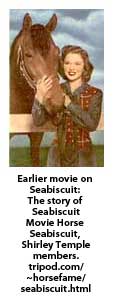This We All Once Believed: Seabiscuit

When we see families in Gary Ross’ nostalgic Seabiscuit, the parents care about one another, the children seem happy, and conflicts revolve around the cosmic tragedies – death, disability, financial loss. The main narrative line of the story follows four individuals stripped of the security and love of their families, by real tragedy, which work together to form a new family – for mutual comfort and encouragement and to preserve and uphold core values. For our world, and, more particularly, our culture gone mad, Seabiscuit offers a glimmer of hope. It is not a flawless film, but most Americans who mourn the passing of the “old days” when ordinary life seemed more ordinary, will find it to be a great film, simply because the values affirmed in Seabiscuit have now become so rare.
At the end of a summer which brought American film goers a sordid stream of comic bookish grotesqueries, capped off by Freddie versus Jason, comes a film with the kind of story many of us grew up on, and one that will certainly become a part of the cultural vocabulary, and better it.
Seabiscuit brings to mind two other films – The Natural and A River Runs Through It. Seabiscuit is a sports genre film with the inevitable build up toward the big race when the underdog will triumph; and, like The Natural, it conveys an appreciation for the sport of horseracing in the idealothe love of green grass and graceful animals and kids leaning against a rail chomping on pieces of grass. Like A River Runs Through It, it tells a moving human story before a beautifully photographed backdrop of a time and place in American history that have become mythic.
Based on a book by Laura Hillenbrand, the story is about the psychological impact of the Depression and how one undersized and temperamental racehorse came to represent the hopes of so many Americans whose lives were shattered in those times.
Jeff Bridges plays Charles Howard, a bicycle repairman who became a pioneer in the automobile industry, only to have tragedy hit the nation and his own family. Partly as therapy, he gets interested in thoroughbreds and takes on a trainer, Tom Smith, whose special gift is with injured or difficult animals. Smith, played brilliantly by Chris Cooper, detects greatness in a mismanaged horse, which has shown little in its career – of course, “the Biscuit.” He determines he can pull out of the horse its true nature, with the help of a young jockey, who has likewise endured his own set of disillusionments, Red Pollard, played by Tobey Maguire.
To tell any more would be to spoil a movie which gives away its punches, as all genre films tend to do, but which still has the power to move us, because it tells a true story – the characters seem real, not plastic; the themes are life-affirming; the art is sincere, not self-congratulatory.
In an age when marketing determines product, when companies poll teenagers to decide what is hip and then create product around that perception, Seabiscuit is completely out of step. This is a movie that assumes that a good story told well will sell itself.
When the horse first appears a third of the way through the movie, and the trainer, Tom Smith first sees him, we are told in a voice-over that Smith thought the horse looked right through him, as if to say, “What the hell are you looking at.” It’s the kind of great line that you would expect John Wayne to utter.
The movie says as much – know who I am and what I believe – what about you?
